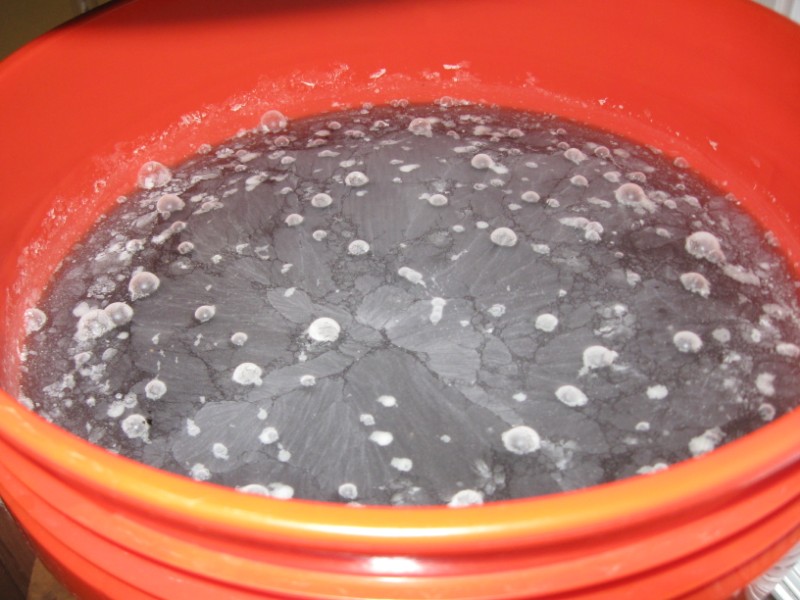hi forum. i suppose this is sort of an ignominious first post, but here goes... i opened up my secondary to bottle this morning, and inside i found this monster.
this is a kolsch after 10 days in the secondary (plastic bucket). the beer looks clear and smells good, sg is 1.010. i haven't had problems with the batch before or after this one, and this batch looked normal when i racked it. i presume that the infection is limited to this secondary fermenter and, since i have used it before without trouble, was introduced during this use.
taste is initially what i would expect from a kolsch, but then a a bit tart or cidery, and sort of clings to the tongue. i detect no horsey, vegetal, or vinegar flavors, such as those typically attributed to brettanomyces, pediococcus or acetobacter respectively. i have seen pictures of brett ferments that look kind of like this but since people usually inoculate with other oranisms at the same time, i don't know which critter causes the pellicle, or whether it's appearance can be used for diagnostic purposes.
i am guessing that this is a lactobacillus infection, i would like to know what the forum thinks. i think the beer is sort of drinkable, my gf thinks it's gross. i guess i will probably throw it out as a matter of principle. i feel that i am generally quite conscientious about sanitation. this is the first time i have had a problem. i use bleach sanitizing solution, at a rate of 2oz/5gallons as described in Papazian. i retire my bottling hoses periodically, and will immediately do so again. i recognize that plastic is more oxygen permeable than glass, and that racking still beer into a secondary with significant head-space, and without purging with co2 introduces oxygen, and a risk of bacterial infection. are there are any other lessons i should take from this?
i'm posting partly for advice, and partly because brewers seem to have an unseemly interest in freaky looking pictures of pellicles. enjoy


this is a kolsch after 10 days in the secondary (plastic bucket). the beer looks clear and smells good, sg is 1.010. i haven't had problems with the batch before or after this one, and this batch looked normal when i racked it. i presume that the infection is limited to this secondary fermenter and, since i have used it before without trouble, was introduced during this use.
taste is initially what i would expect from a kolsch, but then a a bit tart or cidery, and sort of clings to the tongue. i detect no horsey, vegetal, or vinegar flavors, such as those typically attributed to brettanomyces, pediococcus or acetobacter respectively. i have seen pictures of brett ferments that look kind of like this but since people usually inoculate with other oranisms at the same time, i don't know which critter causes the pellicle, or whether it's appearance can be used for diagnostic purposes.
i am guessing that this is a lactobacillus infection, i would like to know what the forum thinks. i think the beer is sort of drinkable, my gf thinks it's gross. i guess i will probably throw it out as a matter of principle. i feel that i am generally quite conscientious about sanitation. this is the first time i have had a problem. i use bleach sanitizing solution, at a rate of 2oz/5gallons as described in Papazian. i retire my bottling hoses periodically, and will immediately do so again. i recognize that plastic is more oxygen permeable than glass, and that racking still beer into a secondary with significant head-space, and without purging with co2 introduces oxygen, and a risk of bacterial infection. are there are any other lessons i should take from this?
i'm posting partly for advice, and partly because brewers seem to have an unseemly interest in freaky looking pictures of pellicles. enjoy





